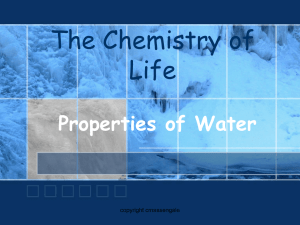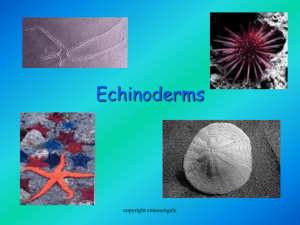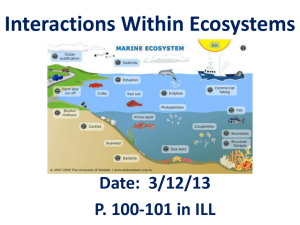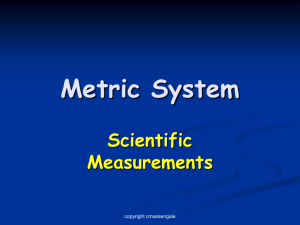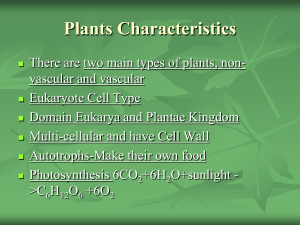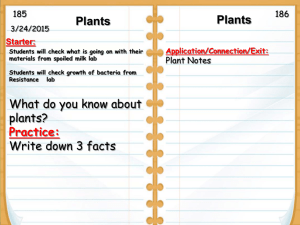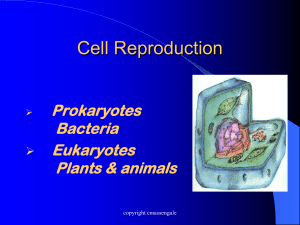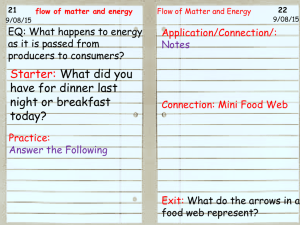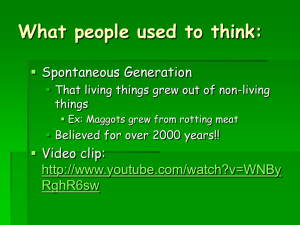Metric System
advertisement
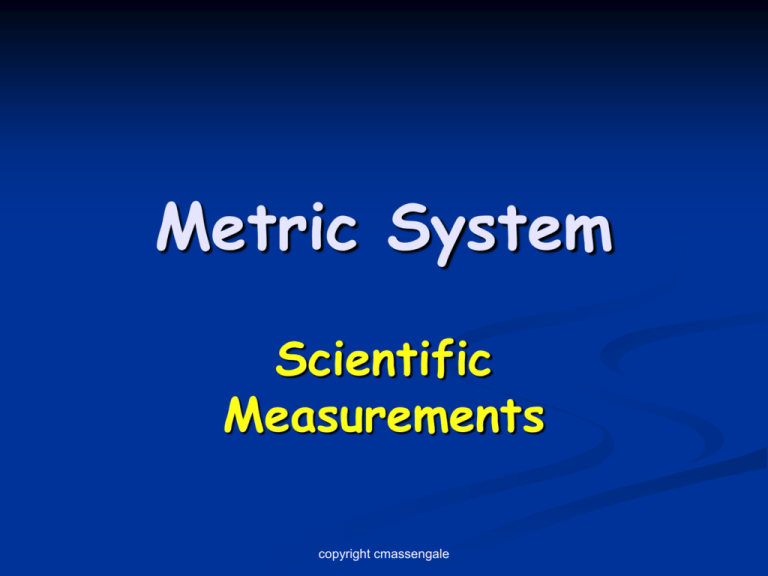
Metric System Scientific Measurements copyright cmassengale Metric System Developed by the French in the late 1700’s. Based on powers of ten, so it is very easy to use. Used by almost every country in the world, with the notable exception of the USA. Especially used by scientists. Abbreviated SI, which is French for Systeme International. copyright cmassengale Metric Prefixes Regardless of the unit, the entire metric system uses the same prefixes. Common prefixes are: kilo = 1000 centi = 1/100th milli = 1/1000th 1 meter = 100 centimeters= 1000 millimeters copyright cmassengale Length Length is the distance between two points. The SI base unit for length is the meter. We use rulers or meter sticks to find the length of objects. copyright cmassengale Mass Mass is the amount of matter that makes up an object. A golf ball and a ping pong ball are the same size, but the golf ball has a lot more matter in it. So the golf ball will have more mass. The SI unit for mass is the gram. A paper clip has a mass of about one gram. The mass of an object will not change unless we add or subtract matter from it. copyright cmassengale Measuring Mass We will use a triple beam balance scale to measure mass. Gravity pulls equally on both sides of a balance scale, so you will get the same mass no matter what planet you are on. copyright cmassengale Weight Weight is a measure of the force of gravity on an object. Your weight can change depending on the force of gravity. The gravity will change depending on the planet you are on. The SI unit for weight is the Newton (N). The English unit for weight is the pound. copyright cmassengale Gravity Gravity is the force of attraction between any two objects with mass. The force depends on two things: more distance = less gravity = less weight less distance = more gravity = more weight more mass = more gravity = more weight less mass = less gravity = less weight copyright cmassengale Volume Volume is the amount of space contained in an object. We can find the volume of box shapes by the formula Volume = length x width x height In this case the units would be cubic centimeters (cm3). So a box 2 cm x 3 cm x 5cm would have a 3 volume of 30 cmcopyright cmassengale V = L x W x H Base Units The base unit for volume is the Liter. We measure volume with a graduated cylinder. copyright cmassengale Graduated Cylinders Liquids form curved, upper surfaces when poured into graduated cylinders To correctly read the volume, read the bottom of the curve called the meniscus copyright cmassengale Water Displacement We can use water displacement to find the volume of objects that are not boxed shaped. We can put water in a graduated cylinder. If a rock causes the level to rise from 7 to 9 ml, the the rock must have a volume of 2-mL. copyright cmassengale Density Density is the amount of matter (mass) compared to the amount of space (volume) the object occupies. We will measure mass in grams and volume in ml or cm3 copyright cmassengale Density Formula Density is mass divided by volume. Density = mass/volume Remember, all fractions are division problems. Since the unit for mass is grams, and the unit for volume is ml or cm3, then the unit for density is g/ml, or g/ cm3 copyright cmassengale Floating and Sinking Less dense materials will float on top of more dense materials. Objects with a density of less than 1-g/mL will float on top of water. Objects with a density greater than 1 g/mL will sink in water. copyright cmassengale Neutral Buoyancy Objects with a density equal to the density of water will float in mid water, at what ever level you place the object. Fish and submarines control their depth by changing their density. copyright cmassengale Objects that Sink! Objects with a density greater than 1 g/mL will sink in water. copyright cmassengale Comparing Densities •Where is the most dense object? •Where is the least dense object? copyright cmassengale Temperature The base unit for temperature is Celsius. C=(F-32)x5/9 C=(93-32)x5/9 33 degrees Celsius copyright cmassengale Time The base unit for time is seconds. copyright cmassengale
